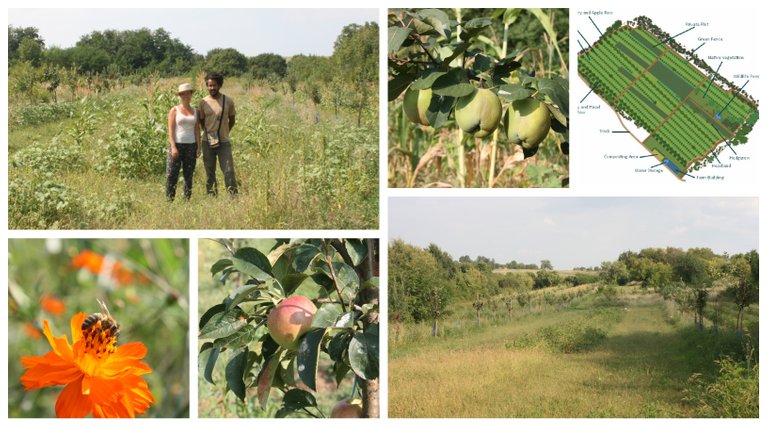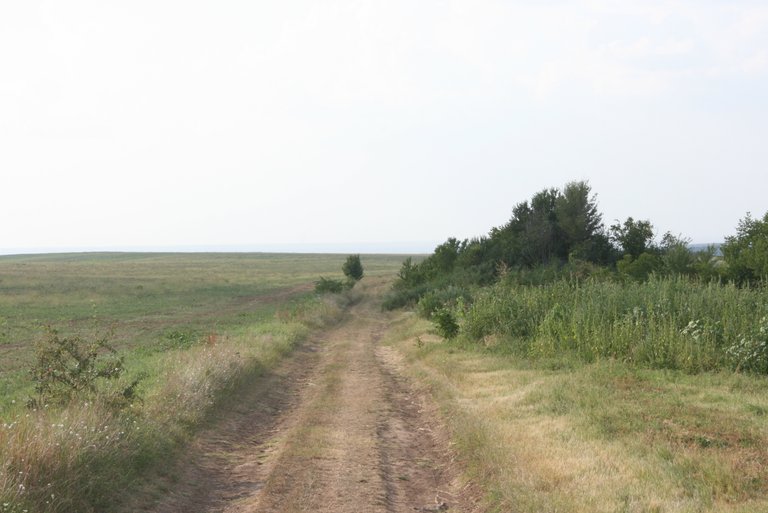Last week Dylan and I set off on a road trip to discover the flora and fauna of the North East of Bulgaria. Our first stop was to Catherine Zanev 's farm in Todorovo, North Bulgaria. As those of you familiar with our project may recall, this was a farm I designed in 2013. I had not visited the place for some time and was very excited to see how the plans had emerged into reality.

Catherine's goals for the plot were to create a polyculture farm with focus on producing fruit for juicing, to include vegetable production for a CSA (Community Supported Agriculture) scheme and to experiment with dye plants. The design was complete by 2015 and implementation began that year.
The 5 ha polyculture plot Suhi Dol on the right, locally practiced intensive monoculture farming on the left
The design concept for Suhi Dol was to create an agroforestry system of "Belts" that are comprised of mixed species fruit trees, soft fruits and nitrogen fixing shrubs planted in "Rows" under-storied with support plants, herbs and perennial vegetables. Between the rows are the "Alleys". The Alleys have potential to be used for growing hay, cereals, vegetables, herbs or rearing pasture raised poultry such as chickens or turkeys. Integrated throughout the belts and around the perimeter are various beneficial habitats to enhance biodiversity. The designed system is an elaboration of Alley Cropping and is based on tried and tested models of our small scale forest garden systems scaled up.

This is the overall site design from 2013

Here are Catherine and her husband Adjmal in the middle of a belt sown with corn in the alleys, shrub rows of aronia and currants, and mixed fruit trees apple, plum, cherry and quince in the tree rows either side of them.
The Plants
The site is developing very well, the trees and shrubs are starting to produce fruits and a diversity of vegetation has established in and around the alleys.
.jpg)
This is a patch of dye plants (not sure of the species) that Catherine has been experimenting with in one of the alleys.
Catherine has also included Maize - Zea mays along with dye plant experiments in the alleys. Here you can see strips of Sulphur Cosmos - Cosmos sulphureus and annual that produces an orange-yellow dye, used in pre-Columbian America and later in southern Africa to dye wool, alongside Zea mays - Corn
The fodder corn is growing well.
The Sulphur Cosmos - Cosmos sulphureus strip was full of Honey Bees - Apis mellifera
The Aronia melanocarpa - Black Chokeberry and Chaenomeles speciosa - Jap. Quince in the shrubs row settled in very well and are producing good quantities of fruits.

Here you can see the polyculture tree rows with local native support plants in between. Catherine is growing more support plants for the inter row sections in a nursery garden in the village.
The support species for the inter rows include
Allium schoenoprasum - Chives
Allium tuberosum - Garlic Chives
Echinacea purpurea - Purple Coneflower
Foeniculum vulgare - Fennel
Sedem telephium - Orpine
Symphytum x uplandicum - Comfrey
A beneficial habitat feature such as a tyre pond, rock pile or early pollenizer polyculture is located in each belt. Here you can see a rock pile. Amphibians and reptiles such as toads, frogs, lizards, slow worms and snakes will benefit from rock piles providing shelter and basking areas. Dylan a keen "herper" who was with me during the visit mentioned that dark rocks would be preferred by the reptiles when basking as they provide better camouflage from predators such as eagles flying above.
Apples are looking great
Quince doing marvellously
Irrigation and Ponds
The middle pond was installed in the spring of 2017. The pond was located in an area to maximize the rainwater runoff collection and filled well this year. This summer the water has been pumped out to irrigate the establishing trees and shrubs via a drip irrigation system. This is a temporary measure until the upper reservoir and barn water catchment is complete. The plan is to integrate a range of aquatic plants into this pond and use it as back up for irrigation when needed. You can find out more about this pond installation in our previous post - Small Pond Installations for Irrigation and Wildlife - Part 1
It is such a great pleasure to see all of those thoughts during the design phase come to life on the ground and to witness the pioneering spirit of Catherine working through all of the obstacles to make it happen.
I continue to work with Catherine on her other sites in the region and I'm looking forward to returning to Bostan Bair this week where we are looking to expand on the implementation of a 80 ha concept design myself and Georgi Pavlov worked on in 2015
If you would like to create a forest garden and gain some practical hands on experience take a look at our course coming up this Autumn. We'll be covering site surveying, landscape design software, installing access, beds, irrigation channels, planting tree, shrub, herb and ground layers and making a small wildlife pond. All in 3 days! And plenty of follow up material to take away with you to digest slowly.
.jpg)






Hi! I am a robot. I just upvoted you! I found similar content that readers might be interested in:
https://balkanecologyproject.blogspot.com/2018/09/5-ha-polyculture-farm-design-suhi-dol.html